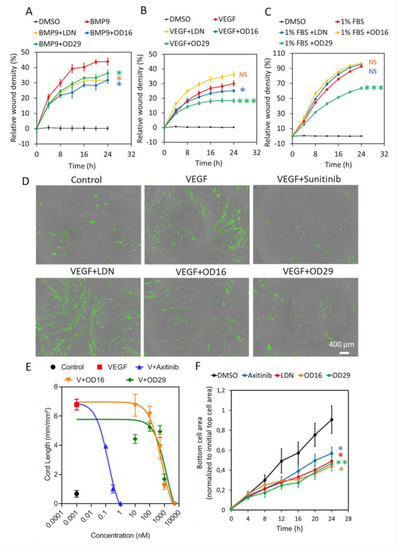Figure 4
- ID
- ZDB-FIG-210707-40
- Publication
- Ma et al., 2021 - Inhibiting Endothelial Cell Function in Normal and Tumor Angiogenesis Using BMP Type I Receptor Macrocyclic Kinase Inhibitors
- Other Figures
- All Figure Page
- Back to All Figure Page
|
OD16 and OD29 attenuate EC migration, cord formation, and invasion in vitro. (A–C) Analysis of the real-time migration behavior of EA.hy926 cells exposed to (A) BMP9 (1 ng/mL), (B) VEGF (15 ng/mL), and (C) 1% FBS in the presence of vehicle control (DMSO), LDN-193189, OD16, or OD29 (0.5 µM) within 24 h. Representative results from three biologically independent experiments are shown as mean ± SD. (D) Cord formation assay of VEGF (15 ng/mL)-stimulated HUVEC-eGFP cells co-cultured with human dermal fibroblasts for 6 days to assess the effects of vehicle control (DMSO), OD16, or OD29 (0.5 µM). The small molecule VEGFR kinase inhibitor Sunitinib (1 μM) and BMPR-I kinase inhibitor LDN-193189 (0.5 µM) were used for comparison. Representative images are shown. Scale bar represents 400 μm. (E) Quantification the effects of OD16 or OD29 (0.5 µM) on VEGF (20 ng/mL)-induced cord formation HUVEC-eGFP cells co-cultured with human dermal fibroblasts over 9 days. The VEGFR kinase inhibitor Axitinib was included for comparison. The cord length is shown as mean ± SD. (F) Effects of vehicle control (DMSO), Axitinib, LDN-193189, OD16, or OD29 (0.5 µM) on HUVEC chemotactic cell invasion (towards full culture medium with 20% FBS and supplements). NS, not significant; * p < 0.05; ** p < 0.005, *** p < 0.001. |

